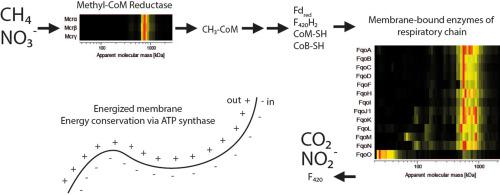Biochimica et Biophysica Acta (BBA) - Bioenergetics ( IF 3.4 ) Pub Date : 2020-09-28 , DOI: 10.1016/j.bbabio.2020.148308 Stefanie Berger 1 , Alfredo Cabrera-Orefice 2 , Mike S M Jetten 1 , Ulrich Brandt 2 , Cornelia U Welte 1

|
The anaerobic oxidation of methane is important for mitigating emissions of this potent greenhouse gas to the atmosphere and is mediated by anaerobic methanotrophic archaea. In a ‘Candidatus Methanoperedens BLZ2’ enrichment culture used in this study, methane is oxidized to CO2 with nitrate being the terminal electron acceptor of an anaerobic respiratory chain. Energy conservation mechanisms of anaerobic methanotrophs have mostly been studied at metagenomic level and hardly any protein data is available at this point. To close this gap, we used complexome profiling to investigate the presence and subunit composition of protein complexes involved in energy conservation processes. All enzyme complexes and their subunit composition involved in reverse methanogenesis were identified. The membrane-bound enzymes of the respiratory chain, such as F420H2:quinone oxidoreductase, membrane-bound heterodisulfide reductase, nitrate reductases and Rieske cytochrome bc1 complex were all detected. Additional or putative subunits such as an octaheme subunit as part of the Rieske cytochrome bc1 complex were discovered that will be interesting targets for future studies. Furthermore, several soluble proteins were identified, which are potentially involved in oxidation of reduced ferredoxin produced during reverse methanogenesis leading to formation of small organic molecules. Taken together these findings provide an updated, refined picture of the energy metabolism of the environmentally important group of anaerobic methanotrophic archaea.
中文翻译:

ANME-2d甲烷营养古细菌中枢能量代谢相关蛋白复合物复合体分析研究
甲烷的厌氧氧化对于减少这种强效温室气体向大气的排放很重要,并且由厌氧甲烷氧化古菌介导。在本研究中使用的“ Candidatus Methanoperedens BLZ2”富集培养物中,甲烷被氧化为 CO 2硝酸盐是厌氧呼吸链的末端电子受体。厌氧甲烷氧化菌的能量守恒机制主要在宏基因组水平上进行研究,目前几乎没有任何蛋白质数据可用。为了弥补这一差距,我们使用复合体分析来研究参与节能过程的蛋白质复合体的存在和亚基组成。鉴定了参与反向产甲烷作用的所有酶复合物及其亚基组成。呼吸链的膜结合酶,例如 F 420 H 2 :醌氧化还原酶、膜结合杂二硫键还原酶、硝酸盐还原酶和 Rieske 细胞色素bc 1复杂的都被检测到了。发现了额外的或推定的亚基,例如作为 Rieske 细胞色素bc 1复合物一部分的八血红素亚基,它们将成为未来研究的有趣目标。此外,还鉴定了几种可溶性蛋白质,它们可能参与反向产甲烷过程中产生的还原铁氧还蛋白的氧化,从而导致小有机分子的形成。综上所述,这些发现提供了对环境重要的厌氧甲烷营养古细菌的能量代谢的更新、精炼的图片。











































 京公网安备 11010802027423号
京公网安备 11010802027423号